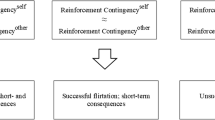Abstract
The present investigation was designed to assess the relationship between empirically defined behavioral strategies and ratings of social effectiveness, liking, and skill. Female subjects rated audiotapes of dyadic heterosocial interactions. The dyads' verbal behavior was manipulated experimentally such that each male “actor” exhibited one of two strategies, other-enhancement and positive self-presentation, and each female coactor exhibited one of two responses, encourages and discourages. After each audiotaped interaction, subjects rated each male on five questions: liking, continued interaction, effectiveness, social skill, and similarity. The results indicated that subjects distinguished between effective and ineffective strategies. The data obtained from all questions indicated that subjects preferred the male who was encouraged irrespective of what strategy he used. This study analyzed relevant variables within an interactional framework allowing for a functional, rather than topographic, analysis of social behavior. From this functional perspective, topographically different heterosocial initiation strategies may be viewed as appropriate or effective based on the reactions of the other person in the interaction.
Similar content being viewed by others
References
Argyle, M. (1967).The psychology of interpersonal behavior. New York: Penguin Books.
Arkowitz, H. (1977). The measurement and modification of minimal dating behavior. In M. Hersen, R. M. Eisler, & P. Miller (Eds.),Progress in behavior modification. New York: Academic Press.
Arkowitz, H., Lichtenstein, E., McGovern, K., & Hines, P. (1975). The behavioral assessment of social competence in males.Behavior Therapy, 6, 3–13.
Bellack, A. S. (1979). A critical appraisal of strategies for assessing social skills.Behavioral Assessment, 1, 157–176.
Bellack, A. S., & Hersen, M. (Eds.) (1979).Research and practice in social skills training. New York: Plenum Press.
Berscheid, E., & Walster, E. H. (1978).Interpersonal attraction (2nd ed.). Reading, MA: Addison-Wesley.
Curran, J. P. (1978). Comments on Bellack, Hersen, and Turner's paper on the validity of roleplay test.Behavior Therapy, 9, 462–468.
Curran, J. P. (1979). Pandora's box reopened? The assessment of social skill.Journal of Behavioral Assessment, 1, 55–72.
DiLorenzo, T. M., & Foster, S. L. (1984). A functional assessment of children's ratings of interaction patterns.Behavioral Assessment, 6, 291–302.
Duncan, S., & Fiske, D. W. (1977).Face-to-face interaction: Research, methods, and theory. Hillsdale, NJ: Lawrence Erlbaum Associates.
Edelstein, B., Sims, C., & Scott, O. (1979).A functional analysis of social competence. Paper presented at the annual meeting of the Association for Advancement of Behavior Therapy, San Francisco.
Fischetti, M., Curran, J. P., & Wessberg, H. W. (1977). Sense of timing: A skill deficit in heterosexual-socially anxious males.Behavior Modification, 1, 179–194.
Fischetti, M., Peterson, J. L., Curran, J. P., Alkire, M., Perrewe, P., & Arland, S. (1984). Social cue discrimination versus motor skill: A missing distinction in social skills assessment.Behavioral Assessment, 1, 27–31.
Foster, S. L., & Ritchey, W. L. (1979). Issues in the assessment of social competence in children.Journal of Applied Behavior Analysis, 12, 625–638.
Freidlander, M. L., & Schwartz, G. S. (1985). Toward a theory of strategic self-presentation in counseling and psychotherapy.Journal of Counseling Psychology, 32, 485–501.
Glasgow, R. E., & Arkowitz, H. (1975). The behavioral assessment of male and female social competence in dyadic heterosexual interactions.Behavior Therapy, 6, 488–498.
Goffman, E. (1959).The presentation of self in everyday life. Garden City, NY: Doubleday.
Greenwald, D. P. (1977). The behavioral assessment of differences in social skill and social anxiety in female college students.Behavior Therapy, 8, 925–937.
Hull, D. B., & Schroeder, H. E. (1979). Some interpersonal effects of assertion, nonassertion, and aggression.Behavior Therapy, 10, 20–28.
Kirk, R. E. (1968).Experimental design: Procedures for the behavioral sciences. Belmont, CA: Brooks/Cole.
Kupke, T. E., Calhoun, K. S., & Hobbs, S. A. (1979). Selection of heterosocial skills. II. Experimental validity.Behavior Therapy, 10, 336–346.
Kupke, T. E., Hobbs, S. A., & Cheney, T. H. (1979). Selection of heterosocial skills. I. Criterionrelated validity.Behavior Therapy, 10, 327–335.
McFall, R. M. (1982). A review and reformulation of the concept of social skills.Behavioral Assessment, 4, 1–33.
Muehlenhard, C. L., Miller, C. L., & Burdick, C. A. (1983). Are high-frequency daters better cue readers? Men's interpretations of women's cues as a function of dating frequency and SHI scores.Behavior Therapy, 14, 626–636.
Patterson, G. R., & Moore, D. (1979). Interactive patterns as units of behavior. In M. E. Lamb, S. J. Suomi, & G. R. Stephenson (Eds.),Social interaction analysis: Methodological issues. Madison: University of Wisconsin Press.
Peterson, J., Fischetti, M., Curran, J. P., & Arland, S. (1981). Sense of timing: A skill deficit in heterosocially anxious women.Behavior Therapy, 12, 195–201.
Peterson, L., Homer, A. L., & Wonderlich, S. A. (1982). The integrity of independent variables in behavior analysis.Journal of Applied Behavior Analysis, 15, 477–492.
Romano, J. M., & Bellack, A. S. (1980). Social validation of a component model of assertive behavior.Journal of Consulting and Clinical Psychology, 48, 478–490.
Scott, W. O. N., & Edelstein, B. A. (1981). The social competence of two interaction strategies: An analog evaluation.Behavior Therapy, 12, 482–492.
Twentyman, C. T., & McFall, R. M. (1975). Behavior training of social skills in shy men.Journal of Consulting and Clinical Psychology, 43, 384–395.
Twentyman, C. T., Boland, T., & McFall, R. M. (1981). Heterosocial avoidance in college males: Four studies.Behavior Modification, 5, 523–552.
Walker, H. M., Greenwood, C. R., Hops, H., & Todd, N. M. (1979). Differential effects of reinforcing topographic components of social interaction.Behavior Modification, 3, 291–321.
Author information
Authors and Affiliations
Rights and permissions
About this article
Cite this article
DiLorenzo, T.M., Edelstein, B.A., Carr, W.T. et al. A functional assessment of heterosocial initiation behaviors in adults. J Psychopathol Behav Assess 12, 67–79 (1990). https://doi.org/10.1007/BF00960454
Accepted:
Issue Date:
DOI: https://doi.org/10.1007/BF00960454




